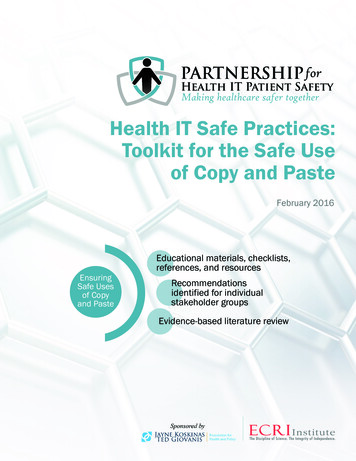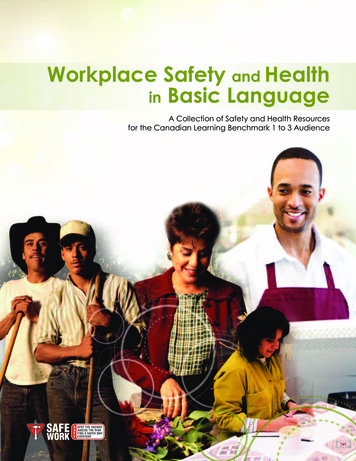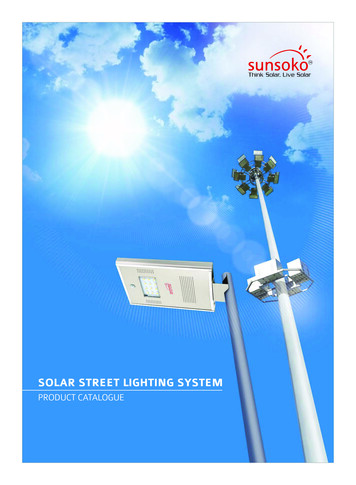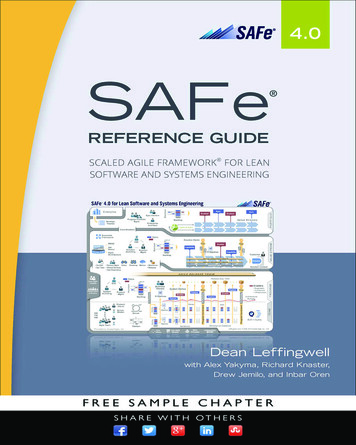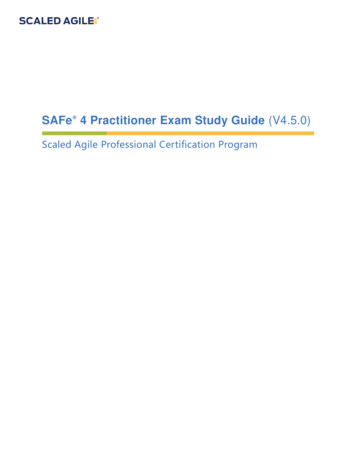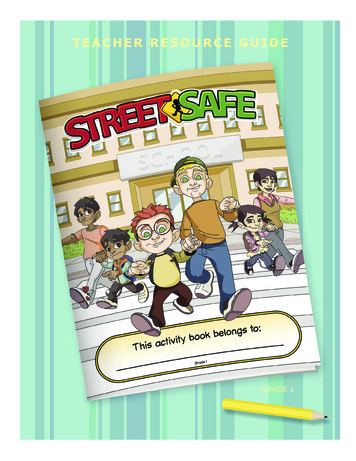
Transcription
I
INTRODUCTION . 1STREET SAFE STUDENT ACTIVITY BOOK CONCEPTS FOR GRADES K–3 . 2GRADE ONE CONNECTIONS TO CURRICULUM . 6LESSON PLANS . 11PAGES 2-3: UNDERSTANDING THAT THERE IS A DANGER ZONEAROUND SCHOOL BUSES . 12PAGE 4: GETTING OFF A SCHOOL BUS AND CROSSING THE STREETSAFELY IN AN URBAN SETTING . 14PAGES 5-6: GETTING OFF A RURAL SCHOOL BUS AND CROSSING THEROAD SAFELY . 16
PAGE 6: DON’T WALK AT THE EDGE OF THE SIDEWALK. 20PAGE 7: NEVER GO BETWEEN PARKED CARS . 21PAGES 8-9: POINT, PAUSE, PROCEED . 22PAGE 10: WAITING FOR THE WALK SIGNAL. 24PAGE 11: FOLLOWING AMA SCHOOL SAFETY PATROLS' INSTRUCTIONSWHEN CROSSING THE ROAD . 25PAGE 12: WEARING A BIKE HELMET PROPERLY . 28PAGES 13-14: SAFE BIKES . 29PAGE 15: STICKER ACTIVITY PAGE/REVIEW . 30PAGE 16: REVIEWING SAFETY LESSONS – “I KNOW” STATEMENTS . 30BLACK LINE MASTERS . 32SONGS AND STORIES. 40CONNECTIONS TO LITERACY . 46CONNECTIONS TO THE WEB. 48OTHER RESOURCES. 48
INTRODUCTIONStreet Safe Student Activity BooksThe Alberta Office of Traffic Safety is producing a series of four educational Student Activity Books(Kindergarten–Grade 3) with the series title “Street Safe”. Student Activity Books cover safety topicsthat are sequenced and appropriate for the targeted grade level, and each grade level has anaccompanying teacher resource. The series uses three illustrated children (Cory, Wyatt and Brooke) toconvey important safety concepts. To reinforce and develop concepts from grade to grade, and toprovide support for combined grade groupings, these children have first been introduced in the StreetSafe Kindergarten Student Activity Book. The three children “age” appropriately and appear in thebooks at each grade level.To order child traffic safety resources contact the Alberta Transportation Office of Traffic Safety at780-422-8839, or 310-0000 toll-free in Alberta.Street Safe Student Activity Book Concepts for Grades K-3This matrix outlines all of the safety concepts that will be explored in the three categories of schoolbus, personal (e.g. safety when riding in vehicles, bike safety) and pedestrian safety at each grade.Grade One Connections to CurriculumThe concepts and activities are cross-curricular. Connections to the curriculum are listed.Lesson PlansThe Grade One book covers three main topics: school bus safety, pedestrian safety and personal(bike) safety. Each section has an overview of the main concepts being presented and lesson plans foreach student page. The activities suggested are varied and include ideas for the whole class, smallgroups or centres as well as activities for inside and outdoors.Black Line MastersBlack Line Masters (BLMs) are reproducible.Songs and StoriesEach section has a song(s) with words set to a well-known tune. Some of the songs were introduced inKindergarten. These can serve as review and in some instances verses have been added to reflectGrade One objectives. It is highly suggested that the teacher rehearse these songs before introducingthem to the class.There are also read-aloud stories that are centred around the concepts that the illustrated childrenhave introduced in the Student Activity Books. Each story has suggestions for discussions to helpdevelop and reinforce student understandings.Connections to LiteracyAn annotated list of fiction and non-fiction books has been compiled for each section or topic.Connections to the WebPlease note that a complete list of web links for your reference has been posted onwww.saferoads.com/streetsafe under “Educator Resources”. Please refer to this source for the mostup-to-date list of relevant and active links.1
STREET SAFE STUDENT ACTIVITY BOOK CONCEPTS FORGRADES K–3KINDERGARTENBUS SAFETYGRADE 1GRADE 2GRADE 3Keeping hands andhead inside the busKeeping voicesquietSitting facingforward at all timesRespecting safetyby not causingcommotions ordistracting thedriverWAITING FOR THE SCHOOL BUSWaiting in a Safe SpotBefore leaving the SafeSpot waiting for: The bus to stopcompletely The driver to signal itis safe to enter thebusUnderstanding theDanger Zone around aschool busAlways staying outsidethe Danger Zone inorder to be seen bythe bus driverSITTING ON THE SCHOOL BUSFacing forwardSitting up straightKeeping feet facing thefrontKeeping safe whentalking to othersacross the aisleGETTING OFF THE SCHOOL BUSAlways holding ontothe handrailTaking five giant stepsaway from the busRespecting others bynever pushingRespecting the safetyof others whenwalking to or from abus: Not touching orpushing the personin front Everybody is beingresponsible forsafetyIn urban areas leavingthe bus and crossingthe road at a corner orcrosswalkIn rural areas leavingthe bus and crossingthe road safely by: Walking ahead ofthe bus by at least10 giant steps Waiting until thedriver signals it issafe2
KINDERGARTENPEDESTRIANSAFETYGRADE 1GRADE 2GRADE 3Understanding thatcars cannot stopinstantly, especiallyin winterWalking where it issafe:BEING A SAFE PEDESTRIANUnderstanding thatmoving vehicles can bea danger to pedestriansStaying away fromcurbs by walking inthe middle of thesidewalkUnderstanding theimportance of beingvisible in all types ofweather and timesof day: Wearing bright orreflective clothing Not wearing darkcoloured clothingat night Being seen inwinter particularlywhen there isvehicle exhaust Walking againsttraffic wherethere are nosidewalks (e.g.,rural roads) Not walking onsnow banksalong the side ofthe roadWatching out for: Vehicles withbackup lights in aparking lot Vehicles backingout of driveways Vehicles comingout of back alleysPaying attentionwhen getting outof a car: Opening vehicledoors on theroad sideCROSSING ROADS SAFELYUnderstanding whathappens at:Never going betweenparked cars CornersChoosing a corner orcrosswalk Pedestrian crossingswith markedcrosswalks Pedestrian crossingsignal lightsUnderstanding theimportance of alwayscrossing in safe placesAlways rememberingto Point, Pause, andProceedFollowing schoolpatrollers’ instructionsChecking that allcars have stoppedeven when: Others say it issafe to cross When a “walk”signal indicates itis safe to crossMaking eye contactwith drivers beforeand while crossingthe roadAlways rememberingto:Paying attention toroad safety signs: Stop Yield Look Stop Cross with an adult PedestrianCrossing Railway Crossing3
KINDERGARTENGRADE 1GRADE 2GRADE 3CROSSING RAILWAYS SAFELYBeing safe atrailway crossings: Never playingaroundrailway/LRT tracks Remembering thattrains have theright of way andcannot stop quickly Looking left andright beforecrossingPERSONALSAFETYBEING SAFE IN VEHICLESAlways buckling upRiding in the backseat for childrenunder 12:Using booster seats Being safe withairbagsBEING SAFE WHEN USING BICYCLESBike equipment safetyUnderstanding thathelmets should: Fit properly Be worn properly(i.e., in the rightposition and withstraps securelyfastened) Always be wornUnderstanding thatbicycles should: Have reflectors,lights or flagsattached to the bikefor increasedvisibility Be the proper sizefor the riderRemembering that abike is a vehicleStopping andlooking in alldirections beforeentering the streetRiding on the rightStopping at all stopsignsWalking bikesacross busy streetsWearing safeclothing (e.g.,reflective clothingand keeping pantlegs tucked in)Knowing handsignals4
KINDERGARTENGRADE 1GRADE 2GRADE 3BEING SAFE WHEN USING INLINE SKATES, SCOOTERS OR SKATEBOARDSWearing propersafety gearSkating and ridingwhere it is safe: On the right sideof paths andtrails Using rinks andparks Staying awayfrom roads andtrafficWatching out fordanger: Staying awayfrom water,rocks, debris Watching forsteps and stairsAlways yielding topedestrians5
GRADE ONE CONNECTIONS TO CURRICULUMLANGUAGE ARTS1.1 DISCOVER AND EXPLORE Share personal experiences that are clearlyrelated to oral, print and other media texts. Talk with others about something recentlylearned. Make observations about activities, experienceswith oral, print and other media texts. Experiment with different ways of exploringand developing stories, ideas and experiences. Choose to read and write for and with others.As students work through the Student ActivityBook, they will share and talk about theirunderstandings and experiences and what theyhave learned about bus, pedestrian and bicyclesafety.All of the pages in the Student Activity Book aremeant to foster discussions about the varioussafety concepts.1.2 CLARIFY AND EXTEND Listen to experiences and feelings of others. Group ideas and information into categoriesdetermined by an adult. Ask questions to get additional ideas andinformation on topics of interest.Students will have opportunities to hear otherstudents’ experiences about riding on a bus andother safety experiences.The students will begin to make connectionsregarding safety such as there are many rulesand practices we need to know to help keep ussafe.2.1 USE STRATEGIES AND CUES Use knowledge of how oral language is used ina variety of contexts to construct and confirmmeaning.As the teacher reads the text in the StudentActivity Book, the students can track the printand read along. Use previous experience and knowledge of orallanguage to make connections to the meaningof oral, print and other media texts. Use knowledge of context, pictures, letters,words, sentences, predictable patterns andrhymes in a variety of oral, print and othermedia texts to construct and confirm meaning.As the teacher reads the text in the StudentActivity Book and the stories provided in theTeacher Resource, students should be encouragedto ask questions. Use knowledge of print, pictures, book coversand title pages to construct and confirmmeaning. Use language prediction skills to identifyunknown words within the context of asentence. Talk about print or other media textspreviously read or viewed. Identify the main idea or topic of simplenarrative and expository texts. Identify by sight some familiar words fromfavourite print texts.The stories included in the Teacher Resource willprovide opportunities for students to recall eventsand characters. The characters that are in theread-aloud stories also appear in the StudentActivity Books.Through the use of the Student Activity Book andactivities in the Teacher Resource, students willhave an opportunity to look at environmentalprint, symbols and signals (e.g., “walk” and“wait” symbols) used in our communities toconvey meaning for everyone.6
Preview book cover, pictures and location oftext to assist with constructing and confirmingmeaning. Use word boundaries, capital letters, periods,question marks and exclamation marks toassist with constructing and confirmingmeaning during oral and silent reading. Use phonic knowledge and skills to readunfamiliar words in context.2.2 RESPOND TO TEXTS Participate in shared listening, reading andviewing experiences, using oral, print and othermedia texts from a variety of cultural traditionsand genres, such as poems, storytelling byelders, pattern books, audiotapes, stories andcartoons.As the Grade One students listen to the stories inthe Teacher Resource and the text in the StudentActivity Book, they will be able to relate personalfeelings and experiences. They can also developtheir understanding of beginning, middle and endof stories. Illustrate and enact stories, rhymes and songs. Remember and retell familiar stories andrhymes. Relate aspects of stories and characters topersonal feelings and experiences.From using the stories provided in the TeacherResource, students will experience hearing astory without looking at pictures and create theirown visualizations of the story. Retell interesting or important aspects of oral,print and other media texts. Tell or represent the beginning, middle and endof stories. Tell, represent or write about experiencessimilar or related to those in oral, print andother media texts. Tell what was liked or disliked about oral, printand other media texts.The Student Activity Book will provide studentsan opportunity to talk about the content andrelate it to their own lives.Opportunities have been provided to allow thestudents to engage in action songs.2.3 UNDERSTAND FORMS, ELEMENTS AND TECHNIQUES Distinguish differences in the ways variousoral, print and other media texts are organized. Identify various forms of media texts. Know that stories have beginnings, middlesand endings. Tell what characters do or what happens tothem in a variety of oral, print and other mediatexts. Demonstrate interest in repetition, rhyme andrhythm in shared language experiences, suchas action songs and word play.Stories are provided in the Teacher Resource. Thestories lend themselves to exploring beginnings,middles and endings of stories. Characters withinthe stories can be discussed.The songs included provide opportunities forstudents to appreciate the sounds and rhythms ofsongs while learning safety concepts.2.4 CREATE ORIGINAL TEXT Generate and contribute ideas for individual orgroup oral, print and other media texts. Change, extend or complete rhymes, rhythmsActivities suggested in the Teacher Resourceprovide opportunities for the students to createtheir own original text by communicating theirexperiences riding a bus, writing a letter to a7
and sounds in pattern stories, poems, nurseryrhymes and other oral, print and other mediatexts. Write, represent and tell brief narratives aboutown ideas and experiences.school bus driver, thank you letter to the schoolpatrollers, as well as other possibilities.As a whole class activity a new verse to one ofthe songs could be created.3.1 PLAN AND FOCUS Explore and share own ideas on topics ofdiscussion and study.Before beginning each section of the student andteacher resources do a KWL chart. Connect information from oral, print and othermedia texts to topics of study discussion. Ask and answer questions to satisfyinformation needs on a specific topic.Brainstorm other ways to find out about trafficsafety other than using the Student Activity Book(e.g., interview a bus driver, AMA School SafetyPatrol or enforcement). Follow spoken directions for gathering ideasand information.3.4 SHARE AND REVIEW Share ideas and information from oral, printand other media texts with familiar audiences. Answer questions directly related to texts.Students can share experiences of times that theyhave used Point, Pause and Proceed.4.1 ENHANCE AND IMPROVE Ask or respond to questions or commentsrelated to the content of own or others’pictures, stories or talk.Students may have opportunities to look back onstories or pictures that they drew and add futuredetails. Rephrase by adding or deleting words, ideas orinformation to make sense. Print letters legibly from left to right, usinglines on a page as a guide.There may be some new terminology thatteachers will be using with their students such as,“vehicles”, “pedestrian”, “signal”, “symbol”,“point”, “pause” or “proceed”. Identify and use an increasing number ofwords and phrases related to personal interestsand topics of study.4.3 PRESENT AND SHARE Present ideas and information to a familiaraudience, and respond to questions. Ask questions to clear up confusinginformation. Be attentive and show interest during listeningor viewing activities.Students could share a made-up story using thelast page in the Student Activity Book (stickerpage) to discuss all the safety aspects they havecreated with their stickers.5.1 RESPECT OTHERS Share ideas and experiences throughconversation, puppet plays, dramatic scenesand songs to celebrate individual and classaccomplishments. Use appropriate words, phrases and sentencesto ask questions, to seek and give assistance,and to take turns.Students can practice respectful language andpractice learned safety vocabulary as theyinterview an AMA School Safety Patrol, bus driveror enforcement.8
MATH1.1 DEVELOP NUMBER SENSESpecific Outcome 3 Indicating that the last number said identifies“how many”.On page 4 of the Student Activity Book thestudents number the steps. They are then askedhow many steps were taken in total.SOCIAL STUDIES1.1.2 VALUE THE GROUPS AND COMMUNITIES TO WHICH THEY BELONG Assume responsibility for their individualchoices and actions.As the students discuss and share personal safetypractices they develop responsible citizenship.1.1.3 EXAMINE HOW THEY BELONG AND ARE CONNECTED TO THEIR WORLDExplore and reflect upon the following question forinquiry: What are our responsibilities and rights athome, at school, in groups and incommunities?Through this safety program, students gain anunderstanding that they belong to a communitythat has rules and practices to help people besafe. Students learn about their personal safetyresponsibilities.1.1.4 DETERMINE WHAT MAKES THEIR COMMUNITIES THRIVEExplore and reflect upon the following questions forinquiry: In what ways do people cooperate in order tolive together peacefully? How do our actions and decisions contribute tothe well-being of groups and communities?Safety rules and practices are explored so thatstudents further develop their understanding ofrules in their community as a way for people tolive together cooperatively.1.1.5 DISTINGUISH GEOGRAPHIC FEATURES IN THEIR OWN COMMUNITY FROM OTHER COMMUNITIESExplore and reflect upon the following questions forinquiry: What are some differences between rural andurban communities?Students can use the illustrations to makeobservations about the differences between urbanand rural communities.9
1.S.6 DEVELOP AGE-APPROPRIATE BEHAVIOUR FOR SOCIAL INVOLVEMENTDevelop age-appropriate behaviour for socialinvolvement as responsible citizens contributingto their community, such as: As students learn and practice safety rules andpractices they grow as socially responsiblecitizens.Behaviour in accordance with classroom,school and community expectations.HEALTHW–1.8 Determine reasons for and apply safety rulesat home and at school (e.g., demonstratefire safety behaviours).As the students learn and develop anunderstanding of the safety rules it helps themappreciate ways in which they can keepthemselves and others safe.W–1.9 Describe and apply appropriate street safetybehaviours in the community (e.g., as apedestrian, passenger, cyclist).The students will learn about school bus safety,crossing streets safely and bicycle safety.10
LESSON PLANSSECTION 1: SCHOOL BUS SAFETY(Student Activity Book pages 2-5)OVERVIEW OF KEY CONCEPTSPAGES 2-3: UNDERSTANDING THAT THERE IS A DANGER ZONE AROUND SCHOOLBUSESPAGE 4: GETTING OFF A SCHOOL BUS AND CROSSING THE STREET SAFELY IN ANURBAN SETTINGPAGE 5: GETTING OFF A RURAL SCHOOL BUS AND CROSSING THE ROAD SAFELY11
BACKGROUND INFORMATION ON SCHOOL BUS SAFETYSchool bus safety research Most school bus incidents occur when children disembark from the bus and disappear fromthe driver's view. It is important to note that most school bus safety related problems tend to occur outside ofthe bus. Almost 2/3 of bus-related fatalities occurred outside of the bus.The Danger Zone The most dangerous area for children is the school bus Danger Zone that extends 3 metres(five big steps) from the bus in all directions. Students should be familiar with this area. If achild can touch the bus, he or she is too close. Every child must know where the Danger Zone is around the school bus. The front and curbside rear of the bus are the most dangerous areas. Children should neverapproach the right rear of the bus. Small children, or children bending over to pick up items,cannot be seen by the bus driver. When near a bus, the children must have the attention of the school bus driver. Children should never play around or near school buses. If a child drops an item near or under a school bus the student should always inform the busdriver who will deal with the problem. Students should never attempt to retrieve itemsthemselves.PAGES 2-3: UNDERSTANDING THAT THERE IS A DANGER ZONEAROUND SCHOOL BUSESINTRODUCING THE CONCEPT: DEVELOPING AN UNDERSTANDING OF THE DANGER ZONE Reviewing what was learned about school bus safety in Kindergarten.oAsk the students what they remember and learned about school bus safety when theywere in Kindergarten.oSing the song “Safety on the Bus” (to the tune of “The Wheels on the Bus”) which isfound in the “Songs and Stories” section. This song was introduced in Kindergartenand reviews the Kindergarten concepts of school bus safety. [Cross Curricular: Music]Listening to a story about the Danger Zone.oRead the story “What Can’t the Bus Driver See?” (See section: “Stories and Songs”.)[Cross Curricular: Language Arts]oReview what the driver can/can’t see from the driver’s seat. Ask the students who isresponsible for safety (e.g., themselves, other children and adults). Remind studentsthat they must be responsible for their own safety and they must help remind othersabout being safe too.12
DEVELOPING THE CONCEPT: UNDERSTANDING THAT IT IS DANGEROUS WHEN YOU ARETOO CLOSE TO A SCHOOL BUS Knowing what actions are dangerous around a school bus. Ask the students to share safetyrules about standing near school buses. Include and develop the following points in the classdiscussion, or read aloud and discuss the ideas. [Cross Curricular: Language Arts]oStay out of the Danger Zone at all times!oRemember — if you can't see the driver, the driver can't see you!oNever go near the school bus unless the driver has given you the signal to come!oNever ever walk or play behind a vehicle!oWhen you go near the school bus, always be sure you can see the bus driver and thebus driver can see you!oIf you drop anything in the Danger Zone, leave it. Never stop to pick it up! The busdriver is responsible for retrieving items.USING THE STUDENT ACTIVITY BOOK Using pages 2-3. Ask students what they see on these two pages. What do they think is theoutlined box around the school bus? The teacher may ask, “If we went out and looked at aschool bus now, would there be a box or shaded area around it?” Explain to the studentsthey must understand that the Danger Zone is an unmarked area that they cannot see.However, it is very important for them to understand and imagine or visualize where theDanger Zone is. [Cross Curricular: Language Arts] Introducing vocabulary. oExplain and discuss the words, “danger” and “zone”. Has anyone heard of the word“zone”? Has anyone heard the word “end zone” in football? “Zone” means “area”.[Cross Curricular: Language Arts]oDiscuss the safety concerns with being too close to a school bus and have the studentsshade in the Danger Zone and draw themselves standing outside the Danger Zone.oTell students that they must be particularly careful around the front of the school busand the curbside rear.Solving Danger Zone problems. Give the following problems to students and ask them tothink of safe solutions. Discuss their suggestions, pointing out the merits or dangers of theirideas.1.Brooke was getting off the bus and dropped her water bottle. It rolled under the bus.(Solution: she MUST let the driver know what has happened. She MUST NOT try andretrieve the bottle herself.)2.Cory sees some kids playing soccer near the school bus. (Solution: he can remind thechildren to play in an area away from the bus, and inform the driver or other adultsabout the potential danger.)3.Wyatt sees a younger child in front of the school bus. (Solution: he can call to thechild and ask the child to get to the safe place where Wyatt is standing. Wyatt alsoMUST let the driver or a nearby adult know and MUST NOT go himself to the front ofthe bus to get the younger child back.)Use this opportunity to discuss any Danger Zone situations that are of personal concern tothe students. [Cross Curricular: Language Arts]13
PRACTICING THE CONCEPTS - INDOORS: DEVELOPING AN UNDERSTANDING OF HOWLARGE THE DANGER ZONE IS Marking out a Danger Zone. In the gym or any other large open space, set up benches ordesks to represent a bus. The students can take five giant steps away from all sides of thepretend bus to mark the Danger Zone. It can then be marked out using skipping ropes,ropes, pylons, beanbags or other easily available items. [Cross Curricular: PhysicalEducation]PRACTICING THE CONCEPTS – OUTDOORS: KNOWING WHERE THE DANGER ZONE IS ATTHE BUS STOP Knowing the Danger Zone at the customary bus stop.oIf possible have a school bus stop at the customary bus stop. Beforehand, chalk outthe Danger Zone around the school bus so that students can actually have a concretepicture of how far away they need to be.oStudents could also take turns sitting on a pillow in the driver's seat and use the busmirrors to see if they can see an adult standing in the Danger Zone.PAGE 4: GETTING OFF A SCHOOL BUS AND CROSSING THE STREETSAFELY IN AN URBAN SETTINGINTRODUCING THE CONCEPT: REVIEWING WHAT WAS LEARNED ABOUT CROSSING ROADSIN KINDERGARTEN Remembering to “Stop! Look! and Cross with an Adult”. Sing the song “Stop!, Look! andCross!” (to the tune of “Frère Jacques”). This was introduced in Kindergarten and can befound in the section “Songs and Stories”. Review the concepts in the song. [CrossCurricular: Music]INTRODUCING THE CONCEPT: UNDERSTANDING THAT YOU ALWAYS WALK AHEAD OF THEBUS TO THE NEAREST CORNERMaterials: slips of paper for making a pictograph. Making a pictograph. Hand out a slip of paper to each student. Ask the students to drawthemselves and to put their name on the slip. Inquire who uses school buses to go to orfrom school and who uses school buses only on field trips. Create a pictograph of these twocategories. Ask the students to suggest titles for the pictograph. This pictograph can be usedfor comparing numbers. [Cross Curricular: Math Extension] Creating a rationale for learning. Remind students that school buses can’t always dropstudents off in front of the doors of buildings they will be entering. Sometimes students willneed to cross roads to get to the proper entrance. Because all students use school buses atsome point, it is important that students learn to leave buses safely and cross roadstogether in a safe manner. Introducing the concept/term “urban”.oPlay “Guess the Secret Words” to encourage students to use their prior knowledge.Tell the students that you are going to write two “secret words” inside a folded piece ofpaper. They will have to guess what the words are based on clues. Write the words“town” and “city”. Ask the students to guess what the words on the paper are based14
on clues (e.g., “You will see many houses here. You will see many roads. These placeshave schools and stores, etc.”).oWhen students correctly guess one of the words, acknowledge their answer as correctand continue giving clues or support for the second word. Open the paper and showthe words to the students. Do simple line drawings [e.g., skyscrapers (cities) or a fewhouses (towns)] alongside the words to assist the students. Tell the children that theyare going to get a new word that they need to know, which means both cities andtowns. Write the word “urban” on the outside of the folded paper. Post the foldedpaper. [Cross Curricular: Social Studies]DEVELOPING THE CONCEPT: STUDENTS WILL LEARN THE PROPER PROCEDURE FORCROSSING THE STREET SAFELY TO AND FROM THE SCHOOL BUS Asking a school bus driver to talk to the students/students preparing questions. A school busdriver who is comfortable with public speaking can talk to the children about his/her job,what is expected of the children on the bus, and how to cross the street safely. Students canbe informed about this visit ahead of time and prepare questions to ask the driver. [CrossCurricular: Language Arts] Reflecting on past school field trips, preparing for future trips. Make connections with fieldtrips that the students either have had, or will have in the future. How would the studentsbe feeling? (E.g., excited or happy.) Ask the students if they are usually thinking aboutsafety when they are on a school trip, or are they thinking about the activity and being withtheir friends. Point out that because students are usually excited and thinking of otherthings, it is important to practice safely leaving buses and crossing roads with a class. Whohelps students be safe on field trips? (E.g., teacher, bus driver, parents.) Remind studentsthat it is important to follow the instructions of all of these people and help each other besafe.USING THE STUDENT ACTIVITY BOOK Using page 4 - pre-reading. Ask students to be reading detectives. Ask the students to findthe word that identifies where the students are going (i.e., swimming pool). Why are thestudents going to the pool? (E.g., on a field trip, for swimming lessons or a class party.)How would the students be feeling? (E.g., excited, happy, uncertain or worried if theyhaven’t had swimming lesso
STREET SAFE STUDENT ACTIVITY BOOK CONCEPTS FOR GRADES K–3 KINDERGARTEN GRADE 1 GRADE 2 GRADE 3 WAITING FOR THE SCHOOL BUS Waiting in a Safe Spot Before leaving the Safe Spot waiting for: The bus to stop completely The driver to signal it is safe to enter




